Many plant exotic lovers are interested in how to grow a banana at home. A houseplant that can bear delicious fruits, and not just purify the air, will become a decoration at home. It is advisable to learn about the features of cultivation and possible difficulties before acquiring the plant.
Material Content:
Features of home growing
Banana is a herbaceous plant, so it has an intensive development of the aerial parts. It blooms, bears fruit, gives many shoots, and dies about 5 years after planting. The fruiting plant is cut, and the processes continue to grow from the root. The root system of indoor banana remains viable for 40 years.
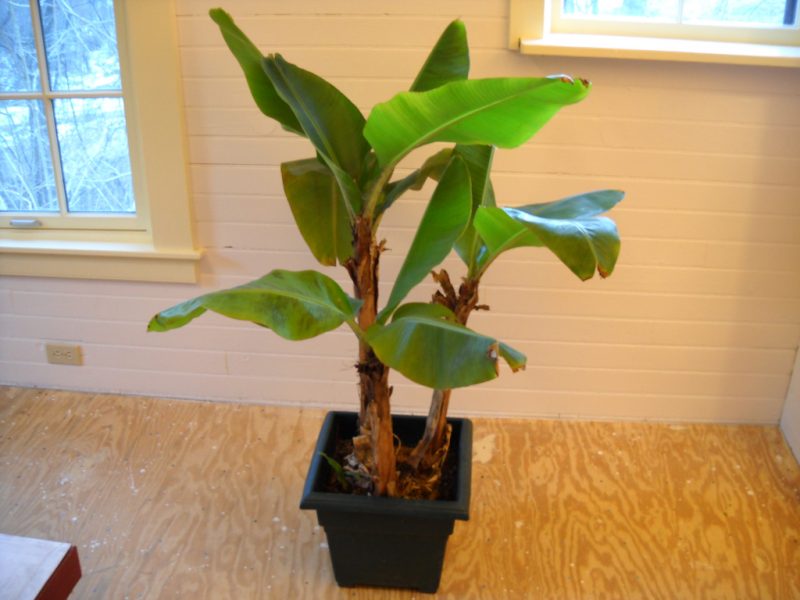
It is important to keep large, like burdock, banana leaves in perfect purity, he likes frequent spraying and a warm shower. After a refreshing shower, it is necessary to remove excess moisture at the base of the leaves to prevent decay of the growth point.
Only at 3 or 4 years of cultivation do the fruits appear. If the plant is about 70 cm high, it may begin to bear fruit in the year of purchase.
Obtaining and germinating seeds from a purchased banana
It is difficult to grow a banana from purchased fruits at home. The fruits are still picked green to bring to the point of sale, so the seeds in the pulp are underdeveloped.
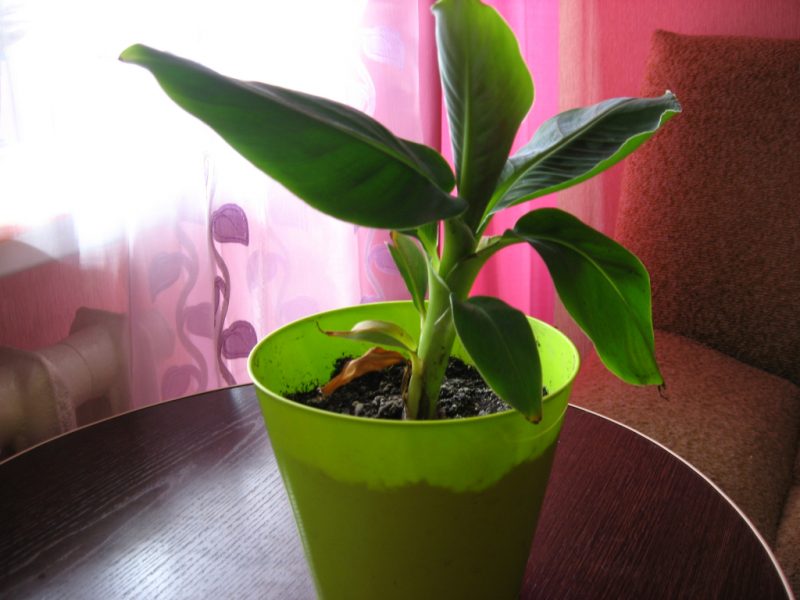
It is better to buy banana seeds in online stores or from lovers of room exotic. For home cultivation, dwarf varieties that do not exceed two meters in height are suitable.
There are dwarf ornamental and fruit bananas. Lavender, velvety and bright red varieties are classified as decorative.Fruit varieties at home can produce a crop of edible, tasty bananas, most of them are hybrids, and only propagate vegetatively, by processes.
Popular varieties:
- Dwarf Cavendish;
- Kiev dwarf;
- Kiev super dwarf.
To germinate a dwarf banana from seeds, you need soil, a flower pot, and drainage. Instead of a landing container, you can use disposable glasses, at the bottom of which drainage holes are punctured. Decorative banana seeds are covered with a strong shell, before planting it needs to be slightly scratched with sandpaper or a file, without damaging the kernel.
Landing procedure:
- expanded clay or ordinary pebbles are poured at the bottom of the landing tank;
- then a mixture of sand and peat in a ratio of 4 to 1 (using fertile soil for germination is not recommended, this can lead to mold or mildew);
- the soil before planting is watered with a solution of potassium permanganate;
- the seeds are lowered for half an hour in a solution of potassium permanganate, then planted in the ground, slightly pressing into the surface, not falling asleep from above;
- cover the container with film, put in a warm, bright place where there is no direct sunlight.
Seeds germinate for a long time, about 3 months. The film is cleaned daily by airing the greenhouse, moisten the substrate by immersion in warm water, tinted with potassium permanganate.
When shoots appear, the film is removed. The grown bananas are transplanted into separate containers with nutritious soil from a mixture of turf, leaf soil, peat and sand. Top necessarily mulch the soil with biohumus (2 cm). In a large pot with a capacity of 50 l, you can plant 3 bananas at once, and they will bear fruit one by one.
Planting a plant in a permanent place
Transshipment of young bananas is done 2 times a year, increasing the pot volume slightly, a small plant can not be immediately planted in a large pot.
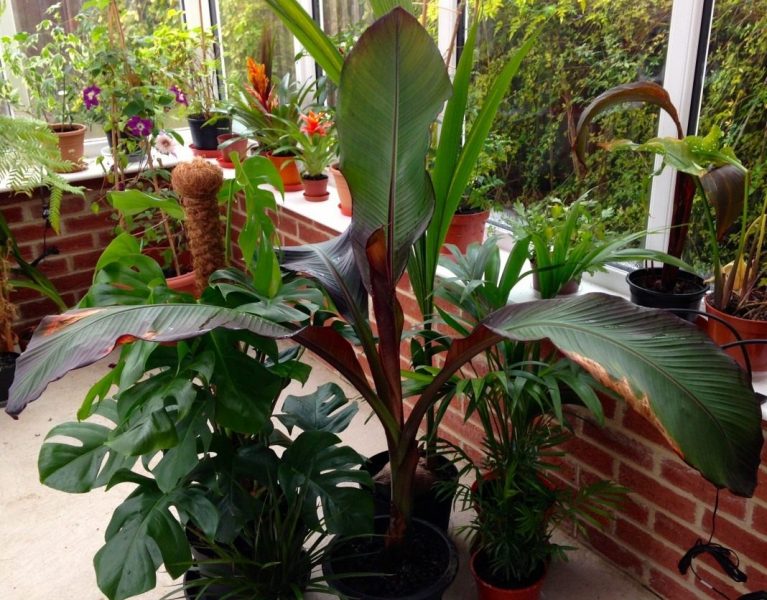
Basic transplant requirements:
- The pot must have a drainage layer and a hole for draining excess water.
- Banana needs neutral or slightly acidic soil. You can cook it yourself by mixing 50% humus and 50% forest land.
- It is desirable that the banana tree in the flower pot be surrounded by a mulching layer. Thanks to him, the soil will be loose, structured.
After transplantation, the plant is watered with a solution of potassium permanganate, which disinfects the soil, and is a growth stimulator. Potassium permanganate is used only at night or when there is no direct sunlight.
Water abundantly so that water passes through the drainage holes. Then, for 1 or 2 weeks, the banana is not touched, the soil is loosened so that the roots breathe, then the plant will take root better.
Banana Care
A banana needs good lighting for proper development. On the southern windows at noon, it must be shaded so that there are no burns. Large leaves intensively evaporate moisture, it is desirable to maintain high humidity in the room or to carry out frequent spraying.
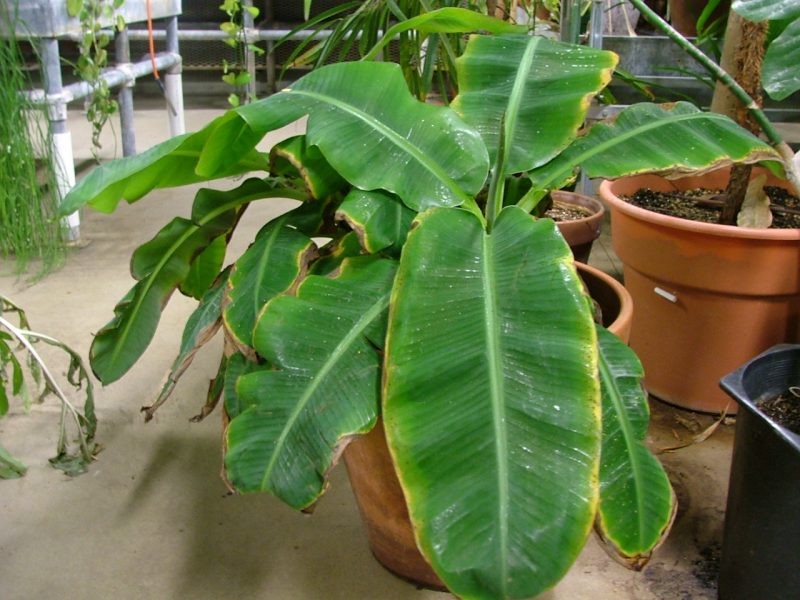
Basic care requirements:
- Do not fill the plant, the soil should dry out between waterings.
- Water temperature 25-30 ° C for watering and spraying, from the cold can rot the roots.
- In winter, the minimum air temperature is +15 ° C; in summer, a banana feels comfortable even at +40 ° C.
- Need regular feeding.
The banana does not need formative pruning. He occasionally dies lower leaves. Old, dried leaf plates cannot be removed at the root itself, this exposes the trunk, and deprives it of natural protection. Cut the dried leaf in the upper part.
Flowering and fruiting of a banana tree
Interestingly, when a banana begins to bear fruit, he throws out a leaf in the form of a heart, and then a peduncle, on which small bananas are tied.
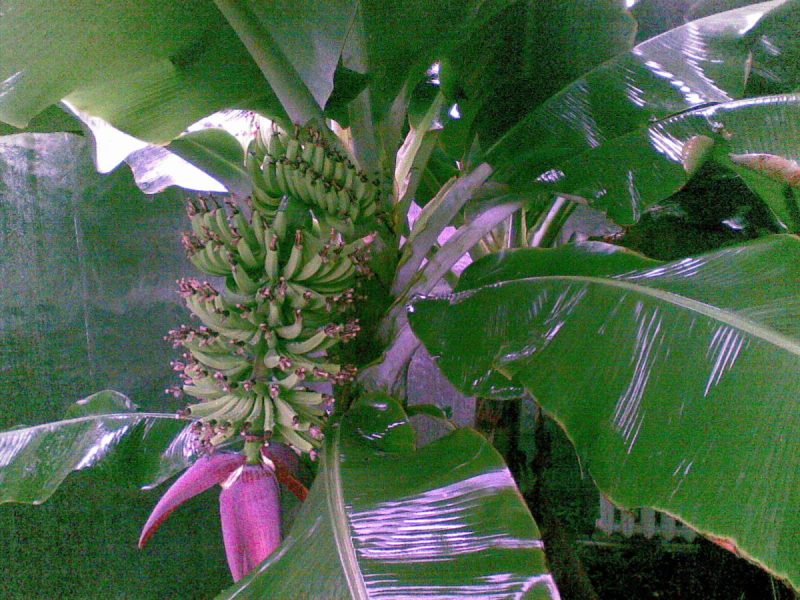
For a plant to bloom and bear fruit, it needs regular top dressing. Fertilize a banana a month after planting. Then regular feeding with wood ash, humus or mullein is necessary. Banana is watered with fish broth once a month, this contributes to flowering (200 or 300 g of fish, boil fish waste in 3 liters of water, do not salt).
It is best to add a small amount of fertilizer at each watering in spring, summer and early autumn. In winter, the amount of fertilizer is reduced.
Pest and Disease Control
Sometimes young leaves on a plant acquire an unnatural light green or yellow color. This disease is called chlorosis. It is caused by a lack of iron in plant cells. To combat chlorosis, the plant is transplanted into a fresh, fertile soil with a slightly acidic reaction. Watered with neutral or slightly acidified water (add 1 drop of lemon juice to 1 liter). For the treatment of chlorosis, complex fertilizers are used, including the trace element iron.
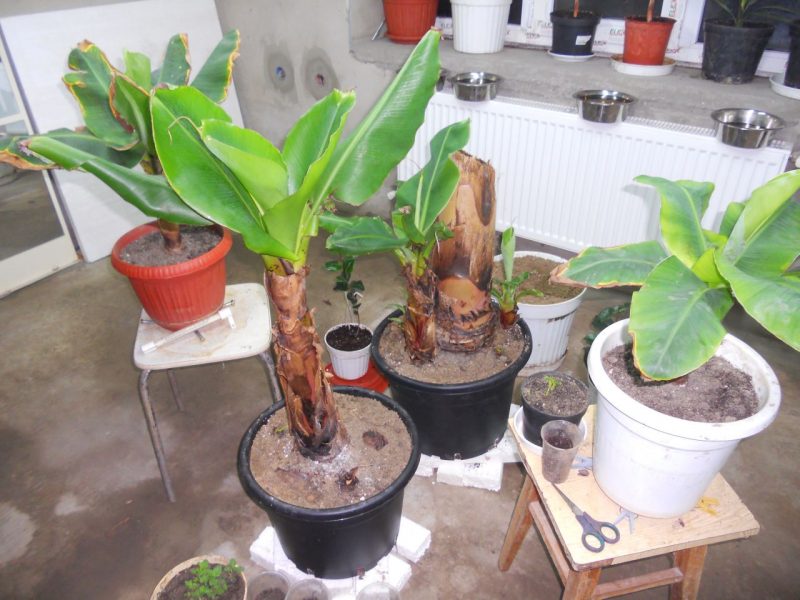
With waterlogging, the banana root often decays, it is difficult to save it even after transplanting, so it is better not to overdo it with watering.
Having noticed indoor pests on the green banana leaves - scab, spider mite or aphid, the plant is sprayed on the leaves with Fitoverm. After 7 days, the treatment is repeated to destroy the insects that have just hatched.
Possible growing difficulties
An inexperienced lover of home exoticism may have difficulty growing a banana.
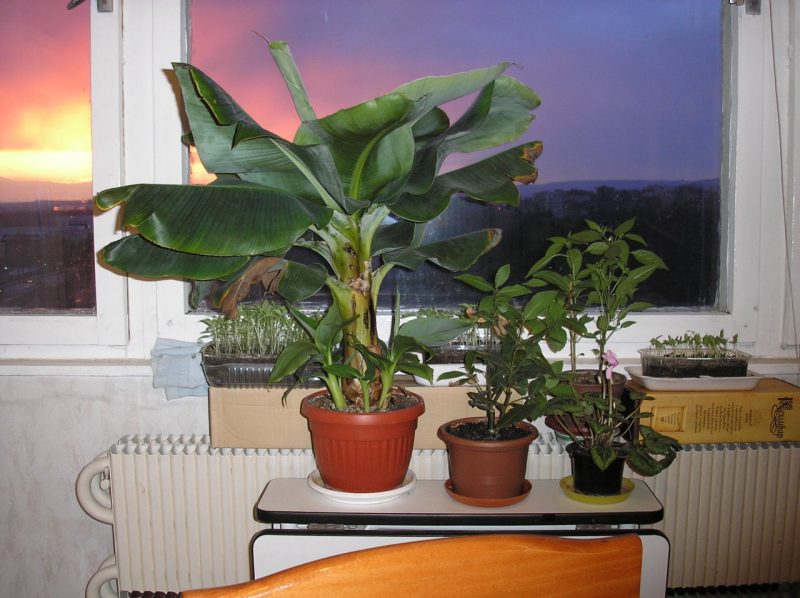
Care errors can be easily fixed if you know what caused them:
- For normal growth, a banana needs a well-lit place, the plant stretches in the shade, its leaves turn yellow.
- From too bright light, the leaves may dry out, they form sunburns.
- A banana tolerates the drying of an earthen coma well and does not respond well to waterlogging. In a constantly moist earth, the root begins to rot, and this leads to its death.
- The lower leaves turn yellow quickly with improper pruning, you can not remove them when they begin to dry. The plant needs moisture and nutrients that are contained in these leaves. Only when they are completely dry can they be cut off.
To grow a crop of fragrant and sweet bananas on your own windowsill is not so difficult. You only need to buy seeds or a small plant, and follow the recommendations for care.












